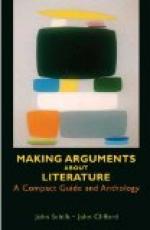In the third place, it is desirable that the proposition should be so framed as to throw the burden of proof on the affirmative. Unless the side which opens the debate has something definite to propose, the debate must open more or less lamely, for it is hard to attack or oppose something which is going to be set forth after you have finished talking. Here, however, as in the case of written arguments, it must be remembered that burden of proof is a vague and slippery term; “he who asserts must prove” is a maxim that in debate applies to the larger issues only, and the average audience will give themselves little trouble about the finer applications of it. If you are proposing a change in present conditions, and the present conditions are not very bad, they will expect you to show why there should be a change, and to make clear that the change you propose will work an improvement. It is only when conditions have become intolerable that an audience thinks first of the remedy. In the ordinary school or college, for example, there is little reason in current conditions for introducing the honor system in examinations: in such a case the burden of proof on the affirmative would be obvious, If, however, as occasionally happens, there has been an epidemic of dishonesty in written work, then the authorities of the school and the parents would want to know why there should not be a change. But it would both bore and confuse an audience to explain to them at length the theory of the shifting of the burden of proof; and the chances are that they would say, “Why doesn’t he prove his point, and not spend his time beating about the bush?”
Finally, the proposition should, if possible, give to the negative as well as to the affirmative some constructive argument. If one side occupies itself wholly with showing the weakness of the arguments on the other side, you get nowhere on the merits of the question; for all that has been shown in the debate, the proposition put forward by the affirmative may be sound, and the only weakness lie in its defenders. Moreover, where the negative side finds no constructive argument on the merits of the question, or elects to confine itself to destructive, arguments, it must beware of the fallacy “of objections”; that is, of assuming that when it has brought forward some objections to the proposition it has settled the matter. As I have so often pointed out in this treatise, no question is worth arguing unless it has two sides; and that is merely saying, in another way, that to both sides there are reasonable objections. Where a negative side confines itself to destructive arguments it must make clear that the objections it presents are really destructive, or at any rate are clearly more grave than those which can be brought against leaving things as they are. And if they confine themselves to destroying the arguments brought forward by the affirmative in this particular debate, they must make clear that these arguments are the strongest that can be brought forward on that side.




